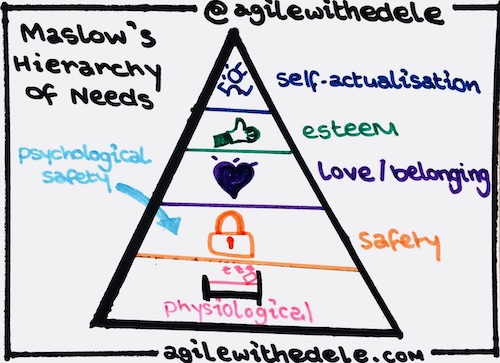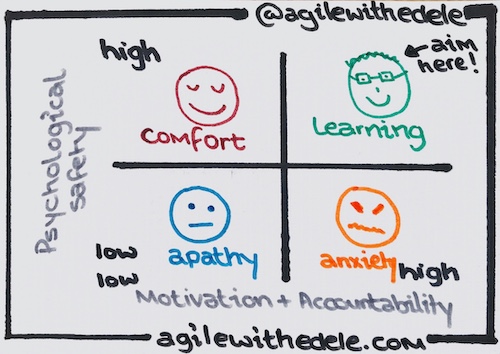Is “psychological safety” simply another buzzword or is there more to it?
You may have only heard of the term in recent years. This is due to the findings of Google’s Project Aristotle where they discovered it was the secret to building the most productive teams. The aim of the project was to find out why some teams excelled while others fell behind, so they studied 180 different teams and 250 different team attributes over a 2-year period in a bid to answer the question: “What makes a team effective at Google?”
The term “psychological safety” actually dates back to the 1960s, when MIT professors Edgar Schein and Warren Bennis explored the concept as a way to help people cope with the uncertainty and anxiety of organisational change in their book, titled, Personal and Organizational Change Through Group Methods. The Laboratory Approach.
To answer whether the term is simply another buzzword, let’s start with the definition: A psychologically safe environment is one in which people feel accepted and respected. This can apply not only to teams, but departments, and even form part of the organisation’s overall culture. The following quote gives a bit more detail to what it’s really about:
Psychological safety exists when people feel their workplace is an environment where they can speak up, offer ideas, and ask questions without fear of being punished or embarrassed.
— Edmondson, A.C (2019). The Fearless Organization: Creating Psychological Safety in the Workplace for Learning, Innovation, and Growth (p. 15)
Why is it so important?
Let’s consider a scenario you’ve most likely been in at work. During a meeting you are confused about the topic being discussed, or perhaps you have the question in your head but you don’t say it out loud. Why? You’re afraid of how you’ll look in front of your colleagues. A similar scenario could be that you have a suggestion for how to approach a problem, but again, out of fear, you remain silent.
Your silence in both of these scenarios holds not only you back, but also your colleagues. You weren’t able to experiment with your suggestion, so you have no idea if it would’ve been successful or not. You don’t know if that one thing could’ve led to your company being more successful. You didn’t try it out, so you can’t learn from it. But at least you don’t look silly, right?!
If you always felt safe in the knowledge that your colleagues wouldn’t judge you for asking a question, or making a suggestion, you’d be more likely to speak up. In doing so you can help to increase agility in your environment - you, your team, even your organisation’s ability to respond well to change will be greatly increased just by making this change. But that doesn’t mean it’s easy - it’s a cultural shift that takes practice.
Feeling safe and secure is one of the basic needs for a person to feel satisfied and motivated, so it’s no surprise that psychologically safety is needed for a team to be motivated. Maslow’s Hierarchy of Needs is a psychological theory regarding how people are motivated, which is depicted in the drawing below. The most fundamental needs lie towards the bottom of the pyramid, which when satisfied, lead us to realise our own potential (self-actualisation).

Experimentation lies at the heart of both agile and change management - fear only holds us back from achieving our goals. If people feel fear, they are most likely not empowered - a key requirement to make decisions and be self-organised. Without self-organisation, you’re not agile - in the same vein, psychological safety is not something you “do once” and then it’s over. It’s something you need to instil every day, and make a conscious effort to contribute towards a safer environment every day.
How to balance Psychological safety and Accountability
These work together, which means you need both to succeed. To do this, it’s important that company leaders and management trust their employees to make their own decisions and do the job they were hired or trained to do. This is often one of the most difficult things for a manager to do, but being able to take a back-seat and trust you have the best people on-board takes courage and leads to success.
The below drawing shows the four quadrants of Psychological Safety (y-axis) vs accountability (x-axis). This is a great chart for explaining how the two concepts work together, and I discovered this quadrant via Amy C. Edmondson’s TED Talk, titled: “Building a psychologically safe workplace”.

Chances are you’re working in an uncertain industry with inter-dependencies. In this case, you’ll want to have ‘high accountability, high psychological safety’, i.e. the learning zone in the top right quadrant. This is also the same quadrant that high-performing teams should be in, and where you want to remain. Once again, psychological safety isn’t something you achieve once and then never do again.
How can you create a psychologically safe environment?
I like to live by the mantra “do what’s right for you.” Of course this doesn’t just apply to safety - you should always be asking yourself and your teams “what are we trying to achieve by doing X?” If you’re doing something just because the Scrum Guide or some online webinar said that you should, question it. But to question it openly, you’re going to need to feel safe.
There are a number of practical ways you can create a more psychologically safe workplace:
- When facilitating meetings, do not single people out. This is a really difficult skill to master, especially when you know some people are more forthcoming than others, but if you put someone on the spot when they’re not comfortable, it’s like watching a rabbit in the headlights.
- Be open about both your own mistakes and successes. Explain how they have helped you to learn and grow, so that people know it’s OK for things to go wrong now and again.
- Encourage your colleagues to inspect and adapt. This process is key to obtaining agility - identify what didn’t go so well, and why, and encourage open discussions about it - you don’t have to wait until your next retrospective to do this!
- Ask for feedback. We all have our personal blind spots, and it’s useful to get constructive feedback from people you work with every day to grow both professionally and as a person.
- Ask a lot of questions, and then ask some more. Nobody has all the answers, even if they look like they do. If one person asks a question, others who were too afraid to ask their question will be more likely to speak up.
- If you’re in management, encourage openness. Have an open door policy, or be more available. If you don’t sit in the same place as the majority of your employees, consider moving desk. Or at least walk-the-floor at least once a week - not to judge, but to actually get to know your colleagues and let them ask questions. I once had a manager ask me at a departmental meeting who I was, despite having worked there for over 1 year - this is not the impression you should be giving your employees.
Takeaways
Whilst you may not work at Google, the outcomes from Aristotle initiative are helpful to the vast majority of organisations, with psychological safety being the most important team dynamic to have. You can start to look in your environment for behaviours that reflect psychological safety, where it’s lacking and identify where you can start to change.
In addition, open your mind by valuing psychological safety in your organisation’s culture, acknowledge that how one team creates a safe environment may not be the same as another. If you want to have a more engaged team, who speak their mind and aren’t afraid to fail and learn - essentially, if you want to obtain agility, you’re going to need to empower your people. Psychological safety is a great step to getting you there.